Opinion | Why US’ anti-China Indo-Pacific Strategy is dangerous, deluded and doomed to fail
- The document reads like a committee-produced mishmash of delusions, false assumptions, wishful thinking and contradictions
- Most of the region’s governments do not actually share US democratic values, even the so-called democracies in Malaysia and Indonesia, making it a hard sell

These words hits the right notes. However, the next stated means of accomplishing the strategy’s goals are to “support India’s continued rise and regional leadership” and “deliver on the Quad”.
These objectives are contradictory. The US needs to explain in detail to Asean and convince its members – particularly its de facto leader Indonesia – how it intends to do this simultaneously without favouring one nation or grouping over another.
Another significant problem is that Asean and the US have fundamentally different visions for the region. The US vision of an implicitly anti-China, security-oriented free and open Indo-Pacific contrasts with Asean’s Outlook on the Indo-Pacific.
The Indo-Pacific Strategy says China is “combining its economic, diplomatic, military and technological might as it pursues a sphere of influence in the Indo-Pacific and seeks to become the world’s most influential power”. The strategy is meant to help prevent this.

